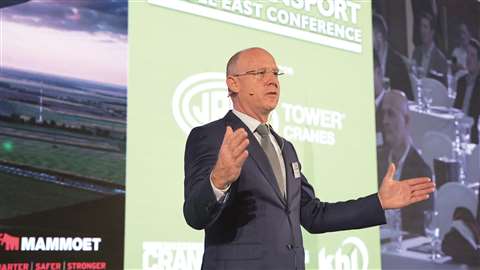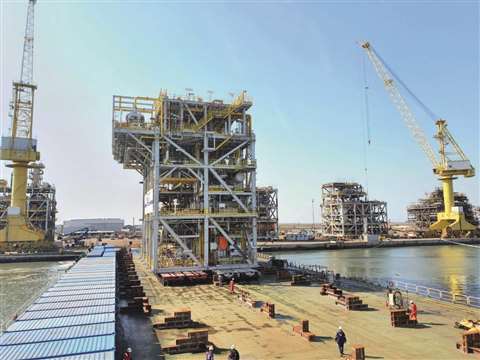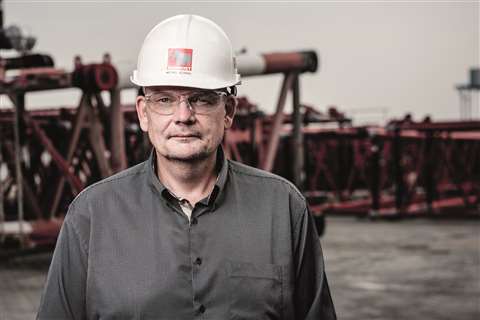The biggest challenge facing the oil and gas sector
06 June 2022
The oil and gas industry remains pivotal in supplying energy globally, and global issues, such as the pandemic and war in Ukraine, force the sector to rapidly adapt. Niamh Marriott reports.
The oil and gas industry will continue to be vital for a considerable amount of time but it is clear that companies are under pressure from consumers and governments to transition away from fossil fuel technology to more sustainable solutions.
 Mammoet CEO Paul van Gelder giving the keynote speech at CATME 2022 in Dubai. (Photo: Mammoet)
Mammoet CEO Paul van Gelder giving the keynote speech at CATME 2022 in Dubai. (Photo: Mammoet)
At the conference CATME (Cranes and Transport Middle East) held in Dubai in March 2022, Paul van Gelder, CEO at global lifting and transport specialist Mammoet, discussed the future of the energy industry, and the much need to move to renewables by speaking directly to the opportunities for the oil and gas sector.
He says that “as renewable energy across the world grows and oil production falls, oil and gas service providers will increasingly find themselves turning to the renewables industry. Margins are lower there, of course, but that is only where the challenge begins.
“These markets grew from entirely different origins, creating whole new ecosystems with regards to quality, to safety, and to innovation.” Over the last ten years, we have seen almost all oil and gas service companies go into renewables,” he notes, “EPCs, dredging companies, transport companies, geological surveyors, the list goes on.”
Van Gelder continues, “There will be work in oil and gas for the coming decades. The volume of this work will start to fall at a certain moment – but this does not have to lead to the erosion of service providers. Though the margins available in the renewables sector may be tighter, there is a bright future for all of us there - if we work to develop a more open-minded approach, to share risk more fairly throughout the value chain, and to allow room for innovation to thrive.”
The transition to renewable energy
It is increasingly difficult to talk about oil and gas without mentioning renewable energy. Inextricable links include the fact that most if not all oil and gas companies are becoming involved, whether it be research, production or power generation.
Deloitte published a recent report which noted five trends that will likely influence the direction of the industry over the next 12 months, from hydrocarbon producers to consumers of energy. Deloitte’s report states that, “Oil demand is back to 95 % of pre-Covid-19 levels… but O&G companies haven’t sat still over the past year.
“Real change is occurring moving into 2022 as many companies look to reinvent themselves by practicing capital discipline (global upstream capex was projected to increase by only 4 % in 2021), by focusing on financial health (debt reduction of 4 % in 2021), and by committing to climate change.
“More North American O&G companies are joining their European counterparts to transform business models and have ESG (environmental social governance) play a larger role in mergers and acquisitions.”
Could price increase boost energy transition?
Deloitte says that higher oil prices will actually boost energy transition plans. “Oil prices have recovered to US$80/bbl after turning negative in April 2020. This escape from the corridor of uncertainty ($40 to $60/ bbl) is significant, but conventional wisdom would suggest that at high oil prices, O&G companies display less capital discipline and would focus more on the core business than on new sustainability opportunities.
 For industry majors oil and gas counts for as much as 90 % of the crane and transport. business in the Middle East
For industry majors oil and gas counts for as much as 90 % of the crane and transport. business in the Middle East
“Thus, it has often been assumed that high oil prices could slow the energy transition. But 76 % of surveyed O&G executives state that oil prices above $60 per barrel will most likely boost or complement their energy transition in the near term.” It continues, “companies pursuing their net-zero goals are either looking to acquire low-carbon-intensity barrels or divest the high-intensity ones, implying that there might be an acreage consolidation or portfolio restructuring on the horizon.”
In terms of a potential loss of skilled workforce, the report claims that “greener jobs and differentiated benefits can help secure return and retention of workforce,” and should be a priority for consideration.
How do sanctions against Russia impact construction?
“Heavy use of materials manufactured using energy-intensive processes is pushing up costs and leaving construction firms exposed to the global energy shortage,” says KHL writer Lucy Barnard. “In March, gas prices surged to crisis levels as Western sanctions introduced in retaliation to Russia’s invasion of Ukraine bit hard into supply already stretched by a global rebound in demand following the pandemic.
“According to Reuters, oil prices have already risen sharply since the pandemic, with the price of Brent crude rocketing from a low of US$24.64 a barrel in April 2020 to $105.25 a barrel in April 2022.
“Russia is the world’s largest exporter of natural gas, accounting for around 45 % of the European Union’s imports in 2021.
“Although the sanctions imposed by Western governments on Russia following its invasion of Ukraine do not include natural resources, most Western trading partners have stopped doing business with the country. Instead, they are trying to make up for the shortfall by searching for alternative suppliers from other countries, increasing demand in a market when supply was already limited due to the rebound following the global Covid pandemic.”
Constructions reliance on Russian oil and gas
Sarens also sees the impact of the war in Ukraine and sanctions. A spokesperson for the international heavy lift and transport specialist says, “In Europe the number of O&G projects is very limited. Main works to be done are linked to revamping or shut-down projects (brown field projects) not green field (new build).
“This is not a recent trend but an already ongoing one for some 10-plus years. The impact of Covid-19 and the war in Ukraine have shown Europe’s dependence on Russian gas. With the latter, we are currently seeing a mobilisation of EU and other non-EU countries dependant on Russian O&G, towards cutting ties with Russia and generating necessary structures and facilities that will secure self-sufficiency or receiving O&G supplies from other countries.
“O&G is a mature market that will eventually be put to bed in the sense that, no matter how our lifting techniques can be inspired by other markets such as the renewables for instance, the sector in itself due to the global demand for a turn to greener energies, will wither and thus, our work as lifters as well,” the Sarens spokesperson continues.
Disruption to Middle East supply chain
Michel Bunnik, MEA regional sales director at mammoet, discussed the latest trends in the oil and gas industry in a recent interview with ICST editor Alex Dahm. Covid, it seems, certainly had a big impact in Dubai and Middle East.
“I think in the Middle East probably the impact of Covid has been bigger than in many other Mammoet regions, or in other countries around the world,” he says.
 Michel Bunnik, Mammoet MEA regional sales director. (Photo: Mammoet)
Michel Bunnik, Mammoet MEA regional sales director. (Photo: Mammoet)
“We believe if you look at the oil majors like Aramco, like Adnoc, right at the start of Covid, they basically stopped all their projects, developments stopped everything ongoing.
“The biggest consequence is that the lack of projects and the implications of the delays Covid had on projects has disrupted the entire supply chain. And unfortunately, as a service provider, we are almost at the very bottom of that supply chain.
“It’s still possible to get work but getting paid or getting paid in time is one of our biggest concerns at the moment. “Over here, 60 to 70 % of our work is oil and gas related. If you look at the project business, probably it’s even more.
“Oil and gas is, has been and probably always will be in this part of the world, the majority of our business. If not oil and gas it’s power generation. For power it includes renewables, to a lesser extent, but power and oil and gas is 80 to 90 % of our business.
“With the lack of projects in the last five to eight years, I would say even in oil and gas, we tried to diversify into the civil markets. Again, that is very difficult, very competitive, in this part of the world due to low pricing and some low standards. For some companies it can be very difficult to add value and to make a difference.
“So yes, it definitely affects us that the traditional oil and gas markets and power is where we believe the majority of our work should be.”
STAY CONNECTED



Receive the information you need when you need it through our world-leading magazines, newsletters and daily briefings.
CONNECT WITH THE TEAM








